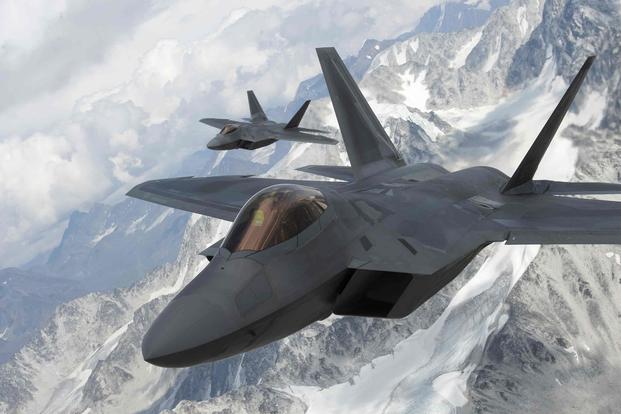Less than a week after U.S. fighter jets intercepted Russian bombers in back-to-back flights off the coast of Alaska, U.S. F-22 Raptors scrambled once again Tuesday to conduct two intercepts of Tu-95 bombers in the same area, according to officials at North American Aerospace Defense Command (NORAD).
The F-22s, accompanied by KC-135 Stratotankers and an E-3 Airborne Warning and Control System, intercepted the Russian aircraft entering the Alaskan Air Defense Identification Zone, which stretches roughly 200 miles off Alaska's coast.
Read Next: First Army Unit Gets Squad Designated Marksman Rifle
NORAD said the first formation of Russian aircraft consisted of two Tu-95 strategic "Bear" bombers escorted by two Su-35 Flanker-E fighter jets, and was supported by an A-50 airborne early warning and control aircraft.
The second pattern consisted of two Tu-95s and an A-50, the command said on Twitter.
"For the eighth time this year, Russian military aircraft have penetrated our Canadian or Alaskan Air Defense Identification Zones and each and every time NORAD forces were ready to meet this challenge," said Gen. Terrence J. O'Shaughnessy, NORAD Commander.
The aircraft came within 32 nautical miles of Alaska's border; but "remained in international airspace," according to the command. "At no time did they enter United States sovereign airspace."
Last week, a similar formation of Russian fighters, bombers and control aircraft came within 20 nautical miles of Alaska's shoreline, but also remained in international airspace.
"Despite the COVID-19 pandemic, NORAD constantly monitors the northern approaches to our nations, and our operations make it clear that we will conduct homeland defense efforts 24 hours a day, 7 days a week, 365 days a year," O'Shaughnessy said.
In April, O'Shaughnessy told reporters that the U.S. military should be mindful that rivals like Russia will look to test any weaknesses among the U.S. and its allies during the coronavirus crisis.
The Russian air forces have also kept tabs on U.S. and NATO activity in Europe.
On May 29, two B-1B Lancers from the 28th Bomb Wing at Ellsworth Air Force Base, South Dakota, marked their first-ever flight with Ukrainian Su-27 Flankers and MiG-29 Fulcrums over the Black Sea. At the same time, B-1s also trained in launching the Long-Range Anti-Ship Missile, known as LRASM.
Russia's Ministry of Defense noted the flight, saying it prompted a Russian Air Force Su-27 and Su-30SM to scramble and intercept the bombers.
The Russian military "feels as if it's necessary to let everybody know that they're still on the world stage, that they're still on the scene, and that they have pretty good military power," retired Gen. Frank Gorenc, the former commander of U.S. Air Forces in Europe, told Military.com in April.
"Declining powers have to do [something]," Gorenc said.
-- Oriana Pawlyk can be reached at oriana.pawlyk@military.com. Follow her on Twitter at @oriana0214.
Related: US Pilots' Close Calls with Russian Aircraft Are Likely to Continue, Experts Say















